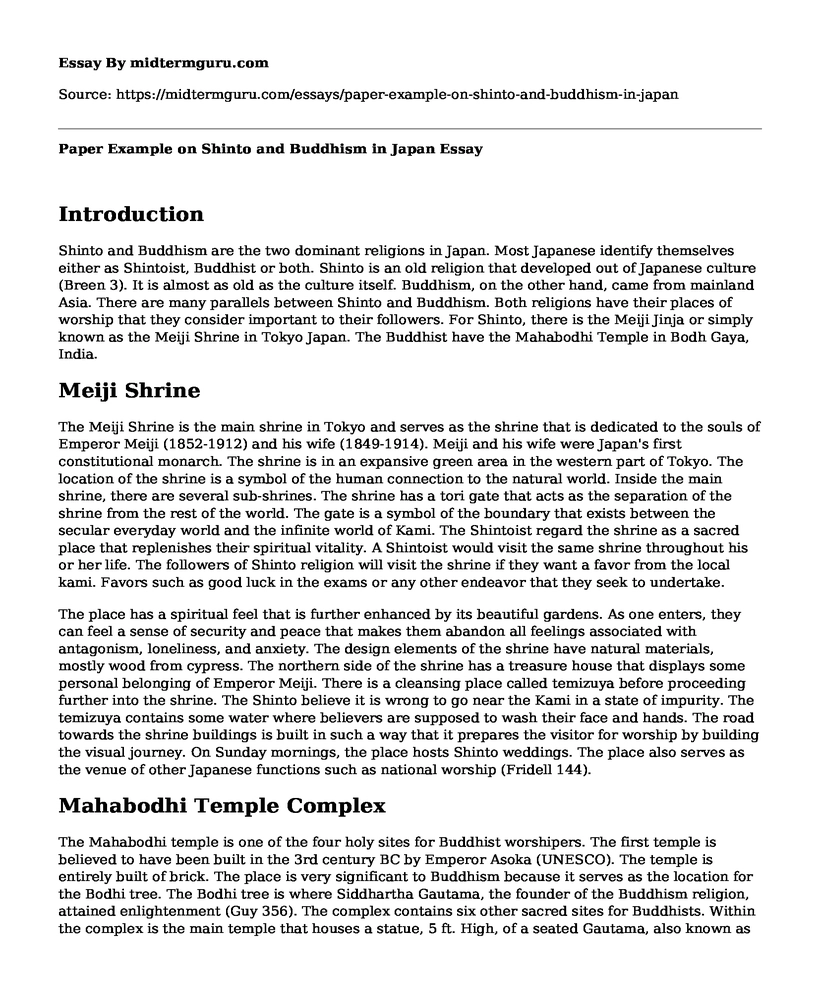Introduction
Shinto and Buddhism are the two dominant religions in Japan. Most Japanese identify themselves either as Shintoist, Buddhist or both. Shinto is an old religion that developed out of Japanese culture (Breen 3). It is almost as old as the culture itself. Buddhism, on the other hand, came from mainland Asia. There are many parallels between Shinto and Buddhism. Both religions have their places of worship that they consider important to their followers. For Shinto, there is the Meiji Jinja or simply known as the Meiji Shrine in Tokyo Japan. The Buddhist have the Mahabodhi Temple in Bodh Gaya, India.
Meiji Shrine
The Meiji Shrine is the main shrine in Tokyo and serves as the shrine that is dedicated to the souls of Emperor Meiji (1852-1912) and his wife (1849-1914). Meiji and his wife were Japan's first constitutional monarch. The shrine is in an expansive green area in the western part of Tokyo. The location of the shrine is a symbol of the human connection to the natural world. Inside the main shrine, there are several sub-shrines. The shrine has a tori gate that acts as the separation of the shrine from the rest of the world. The gate is a symbol of the boundary that exists between the secular everyday world and the infinite world of Kami. The Shintoist regard the shrine as a sacred place that replenishes their spiritual vitality. A Shintoist would visit the same shrine throughout his or her life. The followers of Shinto religion will visit the shrine if they want a favor from the local kami. Favors such as good luck in the exams or any other endeavor that they seek to undertake.
The place has a spiritual feel that is further enhanced by its beautiful gardens. As one enters, they can feel a sense of security and peace that makes them abandon all feelings associated with antagonism, loneliness, and anxiety. The design elements of the shrine have natural materials, mostly wood from cypress. The northern side of the shrine has a treasure house that displays some personal belonging of Emperor Meiji. There is a cleansing place called temizuya before proceeding further into the shrine. The Shinto believe it is wrong to go near the Kami in a state of impurity. The temizuya contains some water where believers are supposed to wash their face and hands. The road towards the shrine buildings is built in such a way that it prepares the visitor for worship by building the visual journey. On Sunday mornings, the place hosts Shinto weddings. The place also serves as the venue of other Japanese functions such as national worship (Fridell 144).
Mahabodhi Temple Complex
The Mahabodhi temple is one of the four holy sites for Buddhist worshipers. The first temple is believed to have been built in the 3rd century BC by Emperor Asoka (UNESCO). The temple is entirely built of brick. The place is very significant to Buddhism because it serves as the location for the Bodhi tree. The Bodhi tree is where Siddhartha Gautama, the founder of the Buddhism religion, attained enlightenment (Guy 356). The complex contains six other sacred sites for Buddhists. Within the complex is the main temple that houses a statue, 5 ft. High, of a seated Gautama, also known as Buddha, holding the earth. The statue is a symbol of Buddha's achieved enlightenment.
From the east, there is a flight of steps that connect to a long central path leading to the main temple. Along with this path, several places mark various events that followed the enlightenment of Buddha. That is the path where the Bodhi tree is situated. To the north of the central park, there is a prayer hall where it is believed Buddha spent his second week after enlightenment. Close to the main temple, there is a platform that represents the place where Buddha meditated. The complex is of great significance to the Buddhist religion because the important events in the life of Lord Buddha took place in the site such as the moment when Prince Siddhartha gained enlightenment and became Buddha. UNESCO terms the site as the most important Buddhist site in the world.
Works Cited
Breen, John, and Mark Teeuwen. Shinto in history: Ways of the kami. Routledge, 2013
Fridell, Wilbur M. "The Establishment of Shrine Shinto in Meiji Japan." Japanese Journal of Religious Studies, vol. 2, no. 2/3, 1975, pp. 137-168. JSTOR, JSTOR, www.jstor.org/stable/30234430.
Guy, John. "The Mahabodhi Temple: Pilgrim Souvenirs of Buddhist India." The Burlington Magazine, vol. 133, no. 1059, 1991, pp. 356-367. JSTOR, JSTOR, www.jstor.org/stable/884751.
UNESCO. Mahabodhi Temple Complex at Bodh Gaya. 2018. Internet. 11 October 2018. <https://whc.unesco.org/en/list/1056>.
Cite this page
Paper Example on Shinto and Buddhism in Japan. (2022, Sep 14). Retrieved from https://midtermguru.com/essays/paper-example-on-shinto-and-buddhism-in-japan
If you are the original author of this essay and no longer wish to have it published on the midtermguru.com website, please click below to request its removal:
- Jesus Christ Reconciliation
- The Book of Mathew Analysis Paper Example
- Essay on Functions of the Buddha in Buddhism
- The Kind of Life of Jesus Possible to Write - Essay Sample
- Research Paper on Protestant Movements
- Christianity: World's Leading Religion With 31.5% of Global Population - Research Paper
- Exploring Christian Combatants' Views on Integration - Essay Sample







